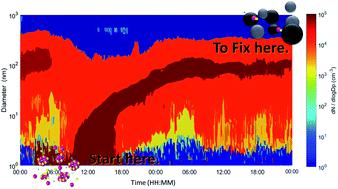当前位置:
X-MOL 学术
›
Faraday Discuss.
›
论文详情
Our official English website, www.x-mol.net, welcomes your
feedback! (Note: you will need to create a separate account there.)
Is reducing new particle formation a plausible solution to mitigate particulate air pollution in Beijing and other Chinese megacities?
Faraday Discussions ( IF 3.3 ) Pub Date : 2020-8-26 , DOI: 10.1039/d0fd00078g Markku Kulmala 1 , Lubna Dada , Kaspar R Daellenbach , Chao Yan , Dominik Stolzenburg , Jenni Kontkanen , Ekaterina Ezhova , Simo Hakala , Saana Tuovinen , Tom V Kokkonen , Mona Kurppa , Runlong Cai , Ying Zhou , Rujing Yin , Rima Baalbaki , Tommy Chan , Biwu Chu , Chenjuan Deng , Yueyun Fu , Maofa Ge , Hong He , Liine Heikkinen , Heikki Junninen , Yiliang Liu , Yiqun Lu , Wei Nie , Anton Rusanen , Ville Vakkari , Yonghong Wang , Gan Yang , Lei Yao , Jun Zheng , Joni Kujansuu , Juha Kangasluoma , Tuukka Petäjä , Pauli Paasonen , Leena Järvi , Douglas Worsnop , Aijun Ding , Yongchun Liu , Lin Wang , Jingkun Jiang , Federico Bianchi , Veli-Matti Kerminen
Faraday Discussions ( IF 3.3 ) Pub Date : 2020-8-26 , DOI: 10.1039/d0fd00078g Markku Kulmala 1 , Lubna Dada , Kaspar R Daellenbach , Chao Yan , Dominik Stolzenburg , Jenni Kontkanen , Ekaterina Ezhova , Simo Hakala , Saana Tuovinen , Tom V Kokkonen , Mona Kurppa , Runlong Cai , Ying Zhou , Rujing Yin , Rima Baalbaki , Tommy Chan , Biwu Chu , Chenjuan Deng , Yueyun Fu , Maofa Ge , Hong He , Liine Heikkinen , Heikki Junninen , Yiliang Liu , Yiqun Lu , Wei Nie , Anton Rusanen , Ville Vakkari , Yonghong Wang , Gan Yang , Lei Yao , Jun Zheng , Joni Kujansuu , Juha Kangasluoma , Tuukka Petäjä , Pauli Paasonen , Leena Järvi , Douglas Worsnop , Aijun Ding , Yongchun Liu , Lin Wang , Jingkun Jiang , Federico Bianchi , Veli-Matti Kerminen
Affiliation

|
Atmospheric gas-to-particle conversion is a crucial or even dominant contributor to haze formation in Chinese megacities in terms of aerosol number, surface area and mass. Based on our comprehensive observations in Beijing during 15 January 2018–31 March 2019, we are able to show that 80–90% of the aerosol mass (PM2.5) was formed via atmospheric reactions during the haze days and over 65% of the number concentration of haze particles resulted from new particle formation (NPF). Furthermore, the haze formation was faster when the subsequent growth of newly formed particles was enhanced. Our findings suggest that in practice almost all present-day haze episodes originate from NPF, mainly since the direct emission of primary particles in Beijing has considerably decreased during recent years. We also show that reducing the subsequent growth rate of freshly formed particles by a factor of 3–5 would delay the buildup of haze episodes by 1–3 days. Actually, this delay would decrease the length of each haze episode, so that the number of annual haze days could be approximately halved. Such improvement in air quality can be achieved with targeted reduction of gas-phase precursors for NPF, mainly dimethyl amine and ammonia, and further reductions of SO2 emissions. Furthermore, reduction of anthropogenic organic and inorganic precursor emissions would slow down the growth rate of newly-formed particles and consequently reduce the haze formation.
更新日期:2020-08-26











































 京公网安备 11010802027423号
京公网安备 11010802027423号